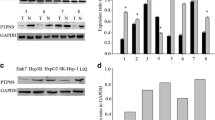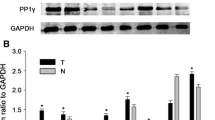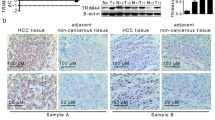Abstract
Hepatocellular carcinoma (HCC) is the second leading cause of cancer mortality and carries a dismal prognosis. The present study aimed to identify the tumour-suppressive role and clinical implications of PTPN13 in HCC progression. We tested the effects of PTPN13 expression in proliferation, invasion, epithelial–mesenchymal transition and associated pathways in HCC cell lines in vitro. Furthermore, its clinical relevance was evaluated in a tissue microarray analysis of samples from 282 HCC patients. Various HCC cell lines expressed relatively low PTPN13 protein levels in vitro. PTPN13 overexpression significantly inhibited the progression of HCC cells, possibly by inhibiting epithelial–mesenchymal transition through inactivation of the EGFR/ERK signalling pathway. Tissue microarray analysis revealed that high PTPN13 expression was correlated with a favourable prognosis in postoperative HCC patients. This study demonstrated the tumour suppressor, PTPN13, as an alternative therapeutic target for HCC.



Similar content being viewed by others
References
Torre LA, Bray F, Siegel RL, et al. Global cancer statistics, 2012. CA: Cancer J Clin. 2015;65(2):87–108.
El-Serag HB. Hepatocellular carcinoma. N Engl J Med. 2011;365:1118–27.
Maluccio M, Covey A. Recent progress in understanding, diagnosing, and treating hepatocellular carcinoma. CA: Cancer J Clin. 2012;62:394–9.
Lemmon MA, Schlessinger J. Cell signaling by receptor tyrosine kinases. Cell. 2010;141:1117–34.
Julien SG, Dube N, Hardy S, Tremblay ML. Inside the human cancer tyrosine phosphatome. Nat Rev Cancer. 2011;11:35–49.
Gao Q, Zhao YJ, Wang XY, et al. Activating mutations in PTPN3 promote cholangiocarcinoma cell proliferation and migration and are associated with tumor recurrence in patients. Gastroenterology. 2014;146:1397–407.
Chan G, Kalaitzidis D, Neel BG. The tyrosine phosphatase Shp2 (PTPN11) in cancer. Cancer Metastasis Rev. 2008;27:179–92.
Zbuk KM, Eng C. Cancer phenomics: RET and PTEN as illustrative models. Nat Rev Cancer. 2007;7:35–45.
Yeh SH, Wu DC, Tsai CY, et al. Genetic characterization of Fas-associated phosphatase-1 as a putative tumor suppressor gene on chromosome 4q21.3 in hepatocellular carcinoma. Clin Cancer Res. 2006;12:1097–108.
Wang Z, Shen D, Parsons DW, et al. Mutational analysis of the tyrosine phosphatome in colorectal cancers. Sci N Y. 2004;304:1164–6.
Zhu JH, Chen R, Yi W, et al. Protein tyrosine phosphatase PTPN13 negatively regulates Her2/ErbB2 malignant signaling. Oncogene. 2008;27:2525–31.
Sotelo NS, Schepens JT, Valiente M, et al. PTEN-PDZ domain interactions: binding of PTEN to PDZ domains of PTPN13. Methods. 2015;77–78:147–56.
Freiss G, Chalbos D. PTPN13/PTPL1: an important regulator of tumor aggressiveness. Anti Cancer Agents Med Chem. 2011;11:78–88.
Sun HC, Zhang W, Qin LX, et al. Positive serum hepatitis B e antigen is associated with higher risk of early recurrence and poorer survival in patients after curative resection of hepatitis B-related hepatocellular carcinoma. J Hepatol. 2007;47:684–90.
Gao Q, Wang XY, Qiu SJ, et al. Overexpression of PD-L1 significantly associates with tumor aggressiveness and postoperative recurrence in human hepatocellular carcinoma. Clin Cancer Res: Off J Am Assoc Cancer Res. 2009;15:971–9.
Zhou SL, Dai Z, Zhou ZJ, et al. Overexpression of CXCL5 mediates neutrophil infiltration and indicates poor prognosis for hepatocellular carcinoma. Hepatol Baltimo, Md. 2012;56:2242–54.
Wang J, Ren J, Wu B, et al. Activation of Rab8 guanine nucleotide exchange factor Rabin8 by ERK1/2 in response to EGF signaling. Proc Natl Acad Sci U S A. 2015;112:148–53.
Hunter T. Tyrosine phosphorylation: thirty years and counting. Curr Opin Cell Biol. 2009;21:140–6.
Abaan OD, Toretsky JA. PTPL1: a large phosphatase with a split personality. Cancer Metastasis Rev. 2008;27:205–14.
Erdmann KS. The protein tyrosine phosphatase PTP-basophil/basophil-like. Eur J Biochem. 2003;270:4789–98.
Ying J, Li H, Cui Y, et al. Epigenetic disruption of two proapoptotic genes MAPK10/JNK3 and PTPN13/FAP-1 in multiple lymphomas and carcinomas through hypermethylation of a common bidirectional promoter. Leukemia. 2006;20:1173–5.
Lucci MA, Orlandi R, Triulzi T, et al. Expression profile of tyrosine phosphatases in HER2 breast cancer cells and tumors. Cell Oncol. 2010;32:361–72.
Wieckowski E, Atarashi Y, Stanson J, et al. FAP-1-mediated activation of NF-kappaB induces resistance of head and neck cancer to Fas-induced apoptosis. J Cell Biochem. 2007;100:16–28.
Kalluri R, Weinberg RA. The basics of epithelial-mesenchymal transition. J Clin Invest. 2009;119:1420–8.
Castilla C, Chinchon D, Medina R, et al. PTPL1 and PKCdelta contribute to proapoptotic signalling in prostate cancer cells. Cell Death Dis. 2013;4:e576.
Castilla C, Flores ML, Conde JM, et al. Downregulation of protein tyrosine phosphatase PTPL1 alters cell cycle and upregulates invasion-related genes in prostate cancer cells. Clin Exp Metastasis. 2012;29:349–58.
Scrima M, De Marco C, De Vita F, et al. The nonreceptor-type tyrosine phosphatase PTPN13 is a tumor suppressor gene in non-small cell lung cancer. Am J Pathol. 2012;180:1202–14.
Glondu-Lassis M, Dromard M, Lacroix-Triki M, et al. PTPL1/PTPN13 regulates breast cancer cell aggressiveness through direct inactivation of Src kinase. Cancer Res. 2010;70:5116–26.
Revillion F, Puech C, Rabenoelina F, et al. Expression of the putative tumor suppressor gene PTPN13/PTPL1 is an independent prognostic marker for overall survival in breast cancer. Int J Cancer. 2009;124:638–43.
Dromard M, Bompard G, Glondu-Lassis M, et al. The putative tumor suppressor gene PTPN13/PTPL1 induces apoptosis through insulin receptor substrate-1 dephosphorylation. Cancer Res. 2007;67:6806–13.
Kawano S, Ikeda W, Kishimoto M, et al. Silencing of ErbB3/ErbB2 signaling by immunoglobulin-like Necl-2. J Biol Chem. 2009;284:23793–805.
Schickel R, Park SM, Murmann AE, Peter ME. miR-200c regulates induction of apoptosis through CD95 by targeting FAP-1. Mol Cell. 2010;38:908–15.
Gloire G, Charlier E, Piette J. Regulation of CD95/APO-1/Fas-induced apoptosis by protein phosphatases. Biochem Pharmacol. 2008;76:1451–8.
Winterhoff BJ, Arlt A, Duttmann A, et al. Characterisation of FAP-1 expression and CD95 mediated apoptosis in the A818-6 pancreatic adenocarcinoma differentiation system. Differentiation. 2012;83:148–57.
Cuppen E, Nagata S, Wieringa B, Hendriks W. No evidence for involvement of mouse protein-tyrosine phosphatase-BAS-like Fas-associated phosphatase-1 in Fas-mediated apoptosis. J Biol Chem. 1997;272:30215–20.
Acknowledgments
This work was supported by the National Natural Science Foundation of China (Grant No. 81502502 and 81472672) and the Yangfan Project for Young Scientists of Shanghai (Grant No. 15YF1402200).
Author information
Authors and Affiliations
Corresponding author
Ethics declarations
This study was conducted in accordance with the ethical principles of research and was approved by the Zhongshan Hospital Ethics Committee. Informed consent was obtained from each patient following institutional review board protocols.
Conflicts of interest
None
Additional information
Hao Zhan, Jiahao Jiang and Chubin Luo share co-first authorship.
Rights and permissions
About this article
Cite this article
Zhan, H., Jiang, J., Luo, C. et al. Tumour-suppressive role of PTPN13 in hepatocellular carcinoma and its clinical significance. Tumor Biol. 37, 9691–9698 (2016). https://doi.org/10.1007/s13277-016-4843-2
Received:
Accepted:
Published:
Issue Date:
DOI: https://doi.org/10.1007/s13277-016-4843-2




